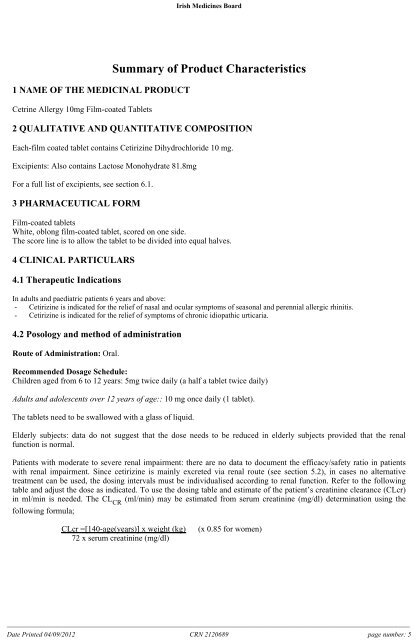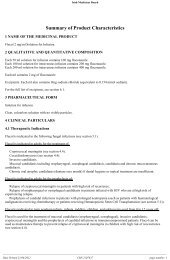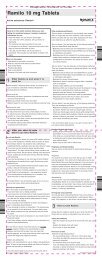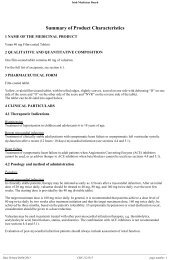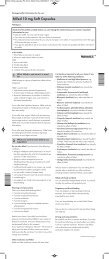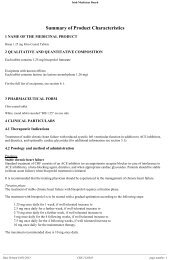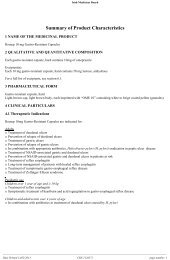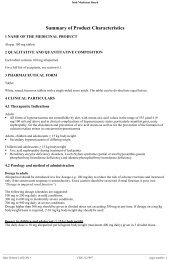Summary of Product Characteristics - Rowex Ltd
Summary of Product Characteristics - Rowex Ltd
Summary of Product Characteristics - Rowex Ltd
You also want an ePaper? Increase the reach of your titles
YUMPU automatically turns print PDFs into web optimized ePapers that Google loves.
Irish Medicines Board1 NAME OF THE MEDICINAL PRODUCTCetrine Allergy 10mg Film-coated Tablets<strong>Summary</strong> <strong>of</strong> <strong>Product</strong> <strong>Characteristics</strong>2 QUALITATIVE AND QUANTITATIVE COMPOSITIONEach-film coated tablet contains Cetirizine Dihydrochloride 10 mg.Excipients: Also contains Lactose Monohydrate 81.8mgFor a full list <strong>of</strong> excipients, see section 6.1.3 PHARMACEUTICAL FORMFilm-coated tabletsWhite, oblong film-coated tablet, scored on one side.The score line is to allow the tablet to be divided into equal halves.4 CLINICAL PARTICULARS4.1 Therapeutic IndicationsIn adults and paediatric patients 6 years and above:- Cetirizine is indicated for the relief <strong>of</strong> nasal and ocular symptoms <strong>of</strong> seasonal and perennial allergic rhinitis.- Cetirizine is indicated for the relief <strong>of</strong> symptoms <strong>of</strong> chronic idiopathic urticaria.4.2 Posology and method <strong>of</strong> administrationRoute <strong>of</strong> Administration: Oral.Recommended Dosage Schedule:Children aged from 6 to 12 years: 5mg twice daily (a half a tablet twice daily)Adults and adolescents over 12 years <strong>of</strong> age:: 10 mg once daily (1 tablet).The tablets need to be swallowed with a glass <strong>of</strong> liquid.Elderly subjects: data do not suggest that the dose needs to be reduced in elderly subjects provided that the renalfunction is normal.Patients with moderate to severe renal impairment: there are no data to document the efficacy/safety ratio in patientswith renal impairment. Since cetirizine is mainly excreted via renal route (see section 5.2), in cases no alternativetreatment can be used, the dosing intervals must be individualised according to renal function. Refer to the followingtable and adjust the dose as indicated. To use the dosing table and estimate <strong>of</strong> the patient’s creatinine clearance (CLcr)in ml/min is needed. The CL CR(ml/min) may be estimated from serum creatinine (mg/dl) determination using thefollowing formula;CLcr =[140-age(years)] x weight (kg)72 x serum creatinine (mg/dl)(x 0.85 for women)______________________________________________________________________________________________________________________Date Printed 04/09/2012 CRN 2120689 page number: 5
Irish Medicines BoardGroup Creatinine Clearance (ml/min) Dosage and frequencyNormal ≥80 10mg once dailyMild 50 – 79 10mg once dailyModerate 30 – 49 5mg once dailySevere ≤30 5 mg once every 2 daysEnd Stage Renal Disease –Patients undergoing dialysis≤10ContraindicatedIn paediatric patients suffering from renal impairment, the dose will have to be adjusted on an individual basis takinginto account the renal clearance <strong>of</strong> the patient and the body weight.Patients with hepatic impairment: no dosage adjustment is required in patients with solely hepatic impairment.Patients with hepatic impairment and renal impairment: dose adjustment is recommended (see Patients with moderateto severe renal impairment above).4.3 ContraindicationsHypersensitivity to the active substance, to any <strong>of</strong> the excipients, to hydroxyzine or to any piperazine derivatives.Patients with severe renal impairment <strong>of</strong> less than 10ml/min creatinine clearance.4.4 Special warnings and precautions for useAt therapeutic doses, no clinically significant interactions have been demonstrated with alcohol (for a blood alcohol level <strong>of</strong>0.5g/L). Nevertheless, precaution is recommended if alcohol is taken concomitantly.Caution in epileptic patients and patients at risk <strong>of</strong> convulsions is recommended.The use <strong>of</strong> the film-coated tablet formulation is not recommended in children aged less than 6 years since this formulation doesnot allow for appropriate dose adaptation.Allergy skin tests are inhibited by antihistamines and a wash-out period (<strong>of</strong> 3 days) is required before performing them.Patients with rare hereditary problems <strong>of</strong> galactose intolerance, the Lapp lactase deficiency or glucose-galactose malabsorptionshould not take this medicine.4.5 Interaction with other medicinal products and other forms <strong>of</strong> interactionDue to the pharmacokinetic, pharmacodynamic and tolerance pr<strong>of</strong>ile <strong>of</strong> cetirizine, no interactions are expected with thisantihistamine. Actually, neither pharmacodynamic nor significant pharmacokinetic interaction was reported in drug-druginteractions studies performed, notably with pseudoephedrine or theophylline (400mg/day).The extent <strong>of</strong> absorption <strong>of</strong> cetirizine is not reduced with food, although the rate <strong>of</strong> absorption is decreased.4.6 Fertility, pregnancy and lactationFor cetirizine, very rare clinical data on exposed pregnancies are available. Animal studies do not indicate direct or indirectharmful effects with respect to pregnancy, embryonal/foetal development, parturition or postnatal development (see 5.3).Caution should be exercised when prescribing to pregnant women.LactationCetirizine is excreted in human milk at concentrations representing 0.25 to 0.90 those measured in plasma, depending on samplingtime after administration. Therefore, caution should be exercised when prescribing cetirizine to lactating women.______________________________________________________________________________________________________________________Date Printed 04/09/2012 CRN 2120689 page number: 6
Irish Medicines Board4.7 Effects on ability to drive and use machinesObjective measurements <strong>of</strong> driving ability, sleep latency and assembly line performance have not demonstrated any clinicallyrelevant effects at the recommended dose <strong>of</strong> 10mg.Patients intending to drive, engaging in potentially hazardous activities or operating machinery should not exceed therecommended dose and should take their response to the medicinal product into account.In sensitive patients, concurrent use with alcohol or other CNS depressants may cause additional reductions in alertness andimpairment <strong>of</strong> performances.4.8 Undesirable effectsClinical studies have shown that cetirizine at the recommended dosage has minor adverse effects on the CNS, includingsomnolence, fatigue, dizziness and headache. In some cases, paradoxical CNS stimulation has been reported.Although cetirizine is a selective antagonist or peripheral H 1-receptors and is relatively free <strong>of</strong> anticholinergic activity,isolated cases <strong>of</strong> micturition difficulty, eye accommodation disorders and dry mouth have been reported.Instances <strong>of</strong> abnormal hepatic function with elevated hepatic enzymes accompanied by elevated bilirubin have beenreported. Mostly this resolves upon discontinuation <strong>of</strong> the treatment with cetirizine dihydrochloride.Clinical trialsDouble blind controlled clinical trials comparing cetirizine to placebo or other antihistamines at the recommendeddosage (10mg daily for cetirizine), <strong>of</strong> which quantified safety data are available, included more than 3200 subjectsexposed to cetirizine.From this pooling, the following adverse events were reported for cetirizine 10mg in the placebo-controlled trials atrates <strong>of</strong> 1.0% or greater:Adverse event(WHO-ART)Cetirizine 10mg(n=3260)Placebo(n=3061)Body as a whole – general disordersFatigue 1.63% 0.95%Central and peripheral nervous system disordersDizziness 1.10% 0.98%Headache 7.42% 8.07%Gastro-intestinal system disordersAbdominal pain 0.98% 1.08%Dry mouth 2.09% 0.82%Nausea 1.07% 1.14%Psychiatric disordersSomnolence 9.63% 5.00%Respiratory system disordersPharyngitis 1.29% 1.34%Although statistically more common than under placebo, somnolence was mild to moderate in the majority <strong>of</strong> cases.Objective tests as demonstrated by other studies have demonstrated that usual daily activities are unaffected at therecommended daily dose in healthy young volunteers.______________________________________________________________________________________________________________________Date Printed 04/09/2012 CRN 2120689 page number: 7
Irish Medicines BoardAdverse reactions at rates <strong>of</strong> 1% or greater in children aged from 6 months to 12 years, included in placebo-controlledclinical trials are:Adverse event(WHO-ART)Cetirizine 10mg(n=1656)Placebo(n=1294)Gastro-intestinal system disordersDiarrhoea 1.0% 0.6%Psychiatric disordersSomnolence 1.8% 1.4%Respiratory system disordersRhinitis 1.4% 1.1%Body as a whole – general disordersFatigue 1.0% 0.3%Post-marketing experienceIn addition to the adverse reactions reported during clinical studies and listed above, the following undesirable effectshave been reported in post-marketing experience.Undesirable effects are described according to MedDRA System Organ Class and by estimated frequency based onpost-marketing experience.Frequencies are defined as follows: Very common (≥1/10); common ((≥1/100 to 1/10) uncommon (≥ 1/1,000 to 1/100)rare (≥ 1/10,000 to
Irish Medicines BoardoSkin and subcutaneous tissue disorders:Uncommon: pruritus, rashRare: urticariaVery rare: angioneurotic oedema, fixed drug eruptiono Renal and urinary disorders:Very rare: dysuria, enuresiso General disorders and administration site conditions:Uncommon: asthenia, malaiseRare: oedemao Investigations:Rare: weight increased4.9 Overdosea) SymptomsSymptoms observed after an overdose <strong>of</strong> cetirizine are mainly associated with CNS effects or with effects that could suggest ananticholinergic effect.Adverse events reported after an intake <strong>of</strong> at least 5 times the recommended daily dose are: confusion, diarrhoea, dizziness,fatigue, headache, malaise, mydriasis, pruritus, restlessness, sedation, somnolence, stupor, tachycardia, tremor, and urinaryretention.b) ManagementThere is no known specific antidote to cetirizine.Should overdose occur, symptomatic or supportive treatment is recommended. Gastric lavage should be considered followingingestion <strong>of</strong> a short occurrence.Cetirizine is not effectively removed by dialysis.5 PHARMACOLOGICAL PROPERTIES5.1 Pharmacodynamic propertiesATC Code and classification:R06A E07 Antiallergic AgentPharmacotherapeutic group:Antihistamine for systemic use Piperazine derivativeCetirizine, a human metabolite <strong>of</strong> hydroxyzine, is a potent and selective antagonist <strong>of</strong> peripheral H 1 -receptors. In vitro receptorbinding studies have shown no measurable affinity for other than H 1 -receptors.In addition to its anti-H 1 effect, cetirizine was shown to display anti-allergic activities: at a dose <strong>of</strong> 10mg once or twice daily, itinhibits the late phase recruitment <strong>of</strong> eosinophils, in the skin and conjunctiva <strong>of</strong> atopic subjects submitted to allergen challenge.Studies in healthy volunteers show that cetirizine, at doses <strong>of</strong> 5 and 10mg strongly inhibits the wheal and flare reactions inducedby very high concentrations <strong>of</strong> histamine into the skin, but the correlation with efficacy is not established.In a 35-day study in children aged 5 to 12, no tolerance to the antihistaminic effect (suppression <strong>of</strong> wheal and flare) <strong>of</strong> cetirizinewas found. When a treatment with cetirizine is stopped after repeated administration, the skin recovers its normal reactivity tohistamine within 3 days.In a six week, placebo-controlled study <strong>of</strong> 186 patients with allergic rhinitis and concomitant mild to moderate asthma, cetirizine10mg once daily improved rhinitis symptoms and did not alter pulmonary function. This study supports the safety <strong>of</strong>administering cetirizine to allergic patients with mild to moderate asthma.In a placebo-controlled study, cetirizine given at the high daily dose <strong>of</strong> 60mg for seven days did not cause statistically significantprolongation <strong>of</strong> QT interval.______________________________________________________________________________________________________________________Date Printed 04/09/2012 CRN 2120689 page number: 9
Irish Medicines BoardAt the recommended dosage, cetirizine has demonstrated that it improves the quality <strong>of</strong> life <strong>of</strong> patients with perennial and seasonalallergic rhinitis.5.2 Pharmacokinetic propertiesThe steady-state peak plasma concentrations is approximately 300ng/ml and is achieved within 1.0 ± 0.5h. No accumulation isobserved for cetirizine following daily doses <strong>of</strong> 10mg for 10 days. The distribution <strong>of</strong> pharmacokinetic parameters such as peakplasma concentration (C max ) and area under curve (AUC), in unimodal in human volunteers.The extent <strong>of</strong> absorption <strong>of</strong> cetirizine is not reduced with food, although the rate <strong>of</strong> absorption is decreased. The extent <strong>of</strong>bioavailability is similar when cetirizine is given as solutions, capsules or tablets.The apparent volume <strong>of</strong> distribution is 0.50l/kg. Plasma protein binding <strong>of</strong> cetirizine is 93 ± 0.3%. Cetirizine does not modify theprotein binding warfarin.Cetirizine does not undergo extensive first pass metabolism. About two third <strong>of</strong> the dose are excreted unchanged in urine. Theterminal half-life is approximately 10 hours.Cetrizine exhibits linear kinetics over the range <strong>of</strong> 5 to 60 mg.Special populationsElderly: Following a single 10mg oral dose, half-life increased by about 50% and clearance decreased by 40% in 16 elderlysubjects compared to the normal subjects. The decrease in cetirizine clearance in these elderly volunteers appeared to be related totheir decreased renal function.Children, infants and toddlers: the half-life <strong>of</strong> cetirizine was about 6 hours in children <strong>of</strong> 6-12 years and 5 hours in children 2-6years. In infants and toddlers aged 6 to 24 months, it is reduced to 3.1 hoursRenally impaired patients: The pharmacokinetics <strong>of</strong> the drug were similar in patients with mild impairment (creatinine clearancehigher than 40ml/min) and healthy volunteers. Patients with moderate renal impairment had a 3-fold increase in half-life and 70%decrease in clearance compared to healthy volunteers.Patients on hemodialysis (creatinine clearance less than 7ml/min) given a single oral 10mg dose <strong>of</strong> cetirizine had a 3-fold increasein half-life and a 70% decrease in clearance compared to normals. Cetirizine was poorly cleared by haemodialysis. Dosingadjustment is necessary in patients with moderate or severe renal impairment (see section 4.2).Hepatically impaired patients: Patients with chronic liver diseases (hepatocellular, cholestatic, and biliary cirrhosis) given 10 or20mg <strong>of</strong> cetirizine as a single dose had a 50% increase in half-life along with 40% decrease in clearance compared to healthysuhjects.Dosing adjustment is only necessary in hepatically impaired patients if concomitant renal impairment is present.5.3 Preclinical safety dataNon-clinical data reveal no special hazard for humans based on conventional studies <strong>of</strong> safety pharmacology, repeated dosetoxicity, genotoxicity, carcinogenic potential, toxicity to reproduction.6 PHARMACEUTICAL PARTICULARS6.1 List <strong>of</strong> excipientsLactose MonohydrateMicrocrystalline CelluloseSilica, Colloidal AnhydrousMagnesium Stearate______________________________________________________________________________________________________________________Date Printed 04/09/2012 CRN 2120689 page number: 10
Irish Medicines BoardFor film-coatingLactose MonohydrateTitanium Dioxide (E171)HypromelloseMacrogol 40006.2 IncompatibilitiesNot applicable.6.3 Shelf life3 years.6.4 Special precautions for storageDo not store above 25°C.6.5 Nature and contents <strong>of</strong> containerCetrine Allergy tablets are packed into PVC/Al blister strips and inserted into a carton.Cetrine Allergy tablets are available in pack sizes <strong>of</strong> 7, 10, 28 and 30 tablets.Not all pack sizes may be marketed.6.6 Special precautions for disposal <strong>of</strong> a used medicinal product or waste materials derived fromsuch medicinal product and other handling <strong>of</strong> the productNot applicable.7 MARKETING AUTHORISATION HOLDER<strong>Rowex</strong> <strong>Ltd</strong>NewtownBantryCo. Cork8 MARKETING AUTHORISATION NUMBERPA 711/75/29 DATE OF FIRST AUTHORISATION/RENEWAL OF THE AUTHORISATIONDate <strong>of</strong> first authorisation: 06 August 2004Date <strong>of</strong> last renewal: 06 August 200910 DATE OF REVISION OF THE TEXTSeptember 2012______________________________________________________________________________________________________________________Date Printed 04/09/2012 CRN 2120689 page number: 11


